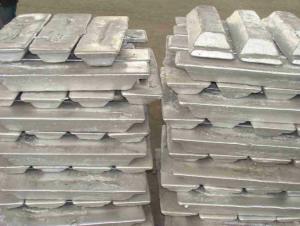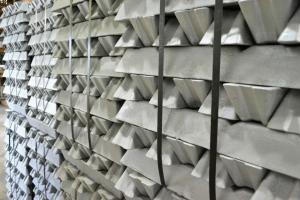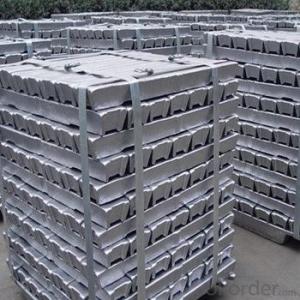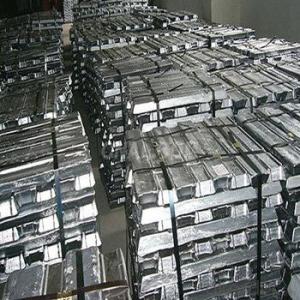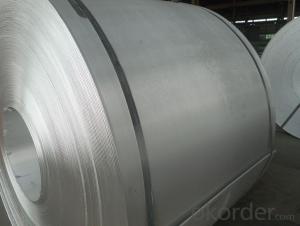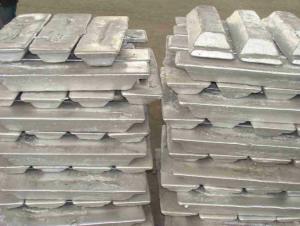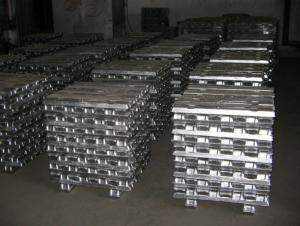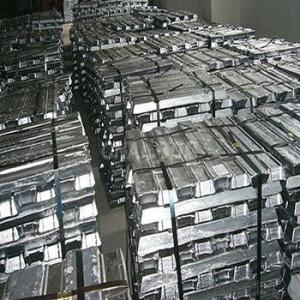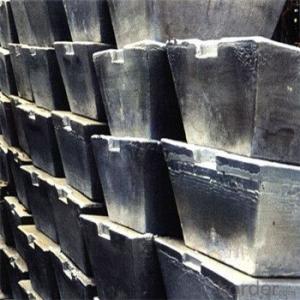Aluminum Ingots AA3003
- Loading Port:
- Shanghai
- Payment Terms:
- TT or LC
- Min Order Qty:
- 20 Tons m.t.
- Supply Capability:
- 1000 Sets Per Month m.t./month
OKorder Service Pledge
OKorder Financial Service
You Might Also Like
1. Specifications of Aluminum Ingots AA3003 Product Name Aluminum Ingot Chemical Composition Al Weight 20/25kg Al (Min) 99%-99.9% Appearance silvery white Advantages easy control and operation, fast melting Chemical composition of Aluminum Ingots AA3003 Grade Chemical Composition % Al≥ Si Fe Cu Ga Mg Zn Mn others Sum Al99.9 99.90 0.50 0.07 0.005 0.02 0.01 0.025 - 0.010 0.10 Al99.85 99.85 0.80 0.12 0.005 0.03 0.02 0.030 - 0.015 0.15 Al99.7 99.70 0.10 0.20 0.010 0.03 0.02 0.030 - 0.030 0.30 Al99.6 99.60 0.16 0.25 0.010 0.03 0.03 0.030 - 0.030 0.40 Al99.5 99.50 0.22 0.30 0.020 0.03 0.05 0.050 - 0.030 0.50 Al99.00 99.00 0.42 0.50 0.020 0.03 0.05 0.050 - 0.050 1.00 2. Usage/Application of Aluminum Ingots AA3003 1. mainly used for melting ingot 5. Used for industry such as automobile,pinning and weaving,electron broadly and so on 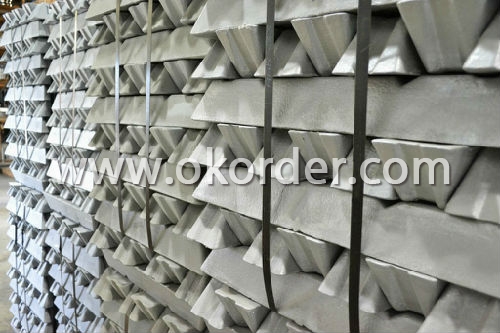
2. discontinuous melting with scrap
3. easy control and operation
4. fast melting
3.Packaging & Delivery of Aluminum Ingots AA3003
About 25Kg /Ingot, Packed in wooden case, Net weight 1000Kg/ Case, or as customer's requirements.
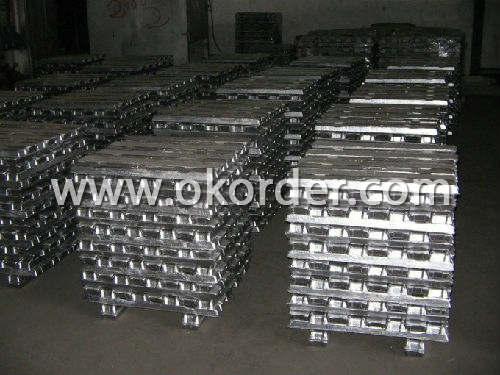
- Q:What is the difference between aluminium ingot YL112 and YLD112?
- The difference between YL112 and YLD112 is that of aluminium ingot:YLD102 is the main alloy element for die casting and forging. It is a silicon second aluminum alloy,
- Q:How is the purity of aluminum ingots determined?
- The purity of aluminum ingots is determined through various analytical techniques and testing methods. One common method used is spectroscopy, specifically inductively coupled plasma optical emission spectroscopy (ICP-OES) or inductively coupled plasma mass spectrometry (ICP-MS). These techniques are capable of analyzing the elemental composition of the aluminum ingot, including the presence of impurities such as iron, silicon, copper, zinc, and others. Another technique employed is atomic absorption spectroscopy (AAS), which focuses on measuring the concentration of specific elements in the aluminum ingot. This method allows for the detection of trace impurities, as it is highly sensitive and selective for individual elements. Chemical analysis is also utilized to determine the purity of aluminum ingots. Acid digestion methods, such as dissolution in nitric acid or hydrochloric acid, are commonly used to dissolve the ingot and create a solution that can be analyzed for impurities. The resulting solution is then subjected to various tests, including titration, colorimetry, or gravimetric analysis, to quantify the impurities present. In addition to these techniques, physical testing methods can be employed to evaluate the purity of aluminum ingots. These methods involve measuring the physical properties of the ingot, such as density, melting point, or electrical conductivity. Deviations from the expected values can indicate the presence of impurities. Overall, determining the purity of aluminum ingots involves a combination of spectroscopic, chemical, and physical analysis techniques, allowing for a comprehensive assessment of the elemental composition and impurity levels in the ingot sample.
- Q:What are the advantages of using aluminum ingots in the production of automotive lightweighting solutions?
- There are several advantages of using aluminum ingots in the production of automotive lightweighting solutions. Firstly, aluminum is a lightweight material, which makes it ideal for reducing the overall weight of vehicles. By using aluminum ingots, manufacturers can significantly reduce the weight of various automotive components, such as body panels, engine parts, and structural elements. This reduction in weight leads to improved fuel efficiency, as lighter vehicles require less energy to accelerate and maintain speed. Additionally, it allows for better handling and maneuverability, enhancing the overall driving experience. Secondly, aluminum is a highly durable material that offers excellent strength-to-weight ratio. This means that even though it is lightweight, aluminum ingots provide sufficient strength and structural integrity to withstand the demands of everyday driving and ensure the safety of passengers. It can also resist corrosion, making it a suitable choice for automotive applications where exposure to harsh weather conditions or road salt is common. Another advantage of using aluminum ingots in automotive lightweighting is their versatility. Aluminum can be easily molded, shaped, and joined using various manufacturing techniques, allowing for the production of complex and intricate designs. This versatility allows manufacturers to create innovative automotive components that meet specific performance requirements without sacrificing weight reduction goals. Moreover, aluminum is a highly recyclable material, making it an environmentally friendly choice for automotive lightweighting solutions. The recycling process for aluminum consumes only a fraction of the energy required for primary production, resulting in fewer greenhouse gas emissions. This not only helps reduce the carbon footprint of the automotive industry but also promotes a more sustainable manufacturing process. Lastly, aluminum ingots offer cost advantages in the long run. While the initial production costs of aluminum components may be higher compared to traditional materials, such as steel, the overall lifecycle costs are often lower. The lightweight nature of aluminum reduces the demand on other vehicle systems, such as brakes and suspension, leading to potential savings in maintenance and replacement costs. Additionally, the recyclability of aluminum allows for the recovery and reuse of the material, reducing the need for new raw material extraction. In conclusion, the advantages of using aluminum ingots in the production of automotive lightweighting solutions include weight reduction, improved fuel efficiency, durability, versatility, environmental friendliness, and long-term cost savings. These benefits make aluminum a preferred choice for manufacturers aiming to enhance the performance, efficiency, and sustainability of modern vehicles.
- Q:Can aluminum ingots be used in the production of musical instruments?
- Yes, aluminum ingots can be used in the production of musical instruments. Aluminum is a lightweight and durable metal that can be molded into various shapes, making it suitable for the construction of instrument bodies, parts, and accessories.
- Q:How are aluminum ingots used in the packaging industry?
- Due to their unique properties and versatility, aluminum ingots play a crucial role in the packaging industry. Various types of aluminum packaging materials, such as cans, foils, containers, and lids, are primarily manufactured using these ingots. Aluminum cans are one of the primary uses of aluminum ingots in the packaging industry. They are widely preferred for packaging beverages like soft drinks, beer, and energy drinks. The lightweight nature of aluminum cans makes them easy to transport and stack, making them more preferable than other materials. Moreover, aluminum cans provide excellent protection against light, oxygen, and moisture, ensuring the freshness and quality of the packaged product. Aluminum foils are another common application of aluminum ingots in the packaging industry. They are used for wrapping food items like chocolates, snacks, and pre-cooked meals. Aluminum foils are also used for sealing bottles and containers. The remarkable barrier properties of aluminum foils prevent the entry of air, moisture, and contaminants, preserving the taste, texture, and overall quality of the packaged food. Aluminum ingots are also utilized in manufacturing aluminum containers, which are commonly known as trays or pans. These containers are extensively used for packaging ready-to-eat meals and takeout food. With their lightweight, durable, and high-temperature resistance properties, aluminum containers are suitable for both cooking and reheating. Furthermore, aluminum ingots are employed in the production of aluminum lids and closures used in the packaging industry. These lids are designed to fit tightly on various packaging materials, ensuring the safety and integrity of the packaged products. Aluminum lids provide an effective seal, preventing leakage, contamination, and tampering. In conclusion, the packaging industry widely utilizes aluminum ingots due to their excellent properties like corrosion resistance, lightweight, and malleability. By using aluminum ingots, the packaging industry can produce sustainable, durable, and high-quality packaging materials that meet the demands of modern consumers.
- Q:How are aluminum ingots used in the production of appliances?
- Appliances heavily rely on aluminum ingots for their production, thanks to the unique properties and characteristics they possess. These ingots are mainly utilized in the manufacturing process to fabricate the outer casings, frames, and components of various appliances. The lightweight nature of aluminum ingots is one of the primary reasons for their utilization. Aluminum is renowned for its lightness, making it an excellent choice for appliances where weight reduction is crucial. This quality enables manufacturers to design and produce appliances that are easier to handle, transport, and install. Moreover, aluminum ingots exhibit exceptional resistance to corrosion, a vital trait for appliances that may come into contact with water or other corrosive substances. This characteristic ensures the durability and longevity of appliances, allowing them to maintain their functionality and appearance over time. Another advantage of utilizing aluminum ingots lies in their high thermal conductivity. This property enables appliances to effectively distribute and dissipate heat, resulting in increased energy efficiency and reduced risk of overheating. This is particularly significant for appliances like refrigerators, air conditioners, and cooktops. Furthermore, aluminum ingots possess high malleability, making it easy to mold and shape them into various sizes and forms. This feature allows manufacturers to create intricate designs and customize the appearance of appliances based on consumer preferences. It also facilitates the integration of different components, such as handles, hinges, and buttons, into the structure of the appliances. Additionally, aluminum ingots are recyclable, making them an environmentally friendly option. The recycling process requires significantly less energy compared to primary aluminum production, thus reducing the carbon footprint associated with appliance manufacturing. In conclusion, the extensive use of aluminum ingots in appliance production is attributed to their lightweight nature, corrosion resistance, high thermal conductivity, malleability, and recyclability. These properties contribute to the creation of durable, energy-efficient, aesthetically pleasing, and environmentally friendly appliances.
- Q:Brief introduction of die casting aluminium ingot
- Product (Unwrought). A product obtained by smelting (or refining) and casting. For example, rolling ingot, extrusion ingot, forging ingot and remelting aluminium ingot.
- Q:How can I extract aluminium ingots from cans?
- The most basic is that you need an open hearth, is heating aluminum cans, but direct melt is not what the meaning of aluminum ingot
- Q:What are the challenges in sourcing sustainable aluminum ingots?
- Sourcing sustainable aluminum ingots presents various challenges. One of the primary obstacles involves ensuring that the aluminum is produced in an environmentally-conscious manner. This entails minimizing energy consumption and carbon emissions linked to the production process. Many aluminum smelters still rely on fossil fuels for energy, which has a significant detrimental effect on the environment. Another challenge lies in verifying the origin of the aluminum. It is crucial to guarantee that the raw materials used in ingot production are ethically sourced and not associated with deforestation, human rights abuses, or conflict zones. This necessitates a robust and transparent supply chain capable of tracing the aluminum back to its source. Additionally, the issue of waste and recycling needs to be addressed. Aluminum is highly recyclable, but significant amounts of aluminum waste still end up in landfills. Encouraging and incentivizing aluminum recycling is vital to mitigate the environmental impact of its production. Furthermore, the availability of sustainable aluminum ingots can be limited. Not all aluminum producers have adopted sustainable practices, resulting in a lack of supply in certain regions or industries. This poses a consistent challenge for businesses seeking to source sustainable aluminum ingots. Overall, addressing these challenges is essential to promote an environmentally-friendly and responsible aluminum industry. By striving for sustainable sourcing practices, we can minimize the environmental impact of aluminum production and contribute to a more sustainable future.
- Q:How are aluminum ingots used in construction?
- Aluminum ingots are widely used in the construction industry for various applications due to their excellent properties and versatility. One common use of aluminum ingots in construction is for the manufacturing of structural components such as beams, columns, and trusses. The lightweight nature of aluminum makes it an ideal choice for these applications as it reduces the overall weight of the structure, leading to cost savings in transportation and installation. Additionally, aluminum ingots are used in the production of cladding systems, which are used to cover the exterior of buildings. These cladding systems provide aesthetic appeal, weather protection, and insulation to the structure. Aluminum's corrosion resistance and durability make it a preferred material for cladding, as it can withstand harsh weather conditions and maintain its appearance over an extended period. Moreover, aluminum ingots are employed in the fabrication of windows, doors, and curtain walls in construction projects. Aluminum frames offer strength and stability while providing a sleek and modern aesthetic. The material's corrosion resistance also ensures that these components remain durable and low-maintenance for a long time. Furthermore, aluminum ingots find applications in roofing systems. Aluminum roofs offer excellent resistance to corrosion, as well as being lightweight and durable. They are also highly reflective, which helps to reduce heat absorption and energy consumption, making them a sustainable choice for buildings. In conclusion, aluminum ingots play a crucial role in the construction industry. Their lightweight nature, corrosion resistance, and durability make them an excellent choice for structural components, cladding systems, windows, doors, curtain walls, and roofing systems. The use of aluminum ingots in construction not only enhances the overall aesthetics of the building but also contributes to its longevity, energy efficiency, and sustainability.
1. Manufacturer Overview |
|
|---|---|
| Location | Henan,China |
| Year Established | 1993 |
| Annual Output Value | Above US$200 Million |
| Main Markets | Mid East;Eastern Europe;North America |
| Company Certifications | ISO 9001:2000;ISO 14001:2004;OHSAS 18001 |
2. Manufacturer Certificates |
|
|---|---|
| a) Certification Name | |
| Range | |
| Reference | |
| Validity Period | |
3. Manufacturer Capability |
|
|---|---|
| a)Trade Capacity | |
| Nearest Port | Shanghai |
| Export Percentage | 30%-50% |
| No.of Employees in Trade Department | 21-50 People |
| Language Spoken: | English;Chinese |
| b)Factory Information | |
| Factory Size: | Above 100,000 square meters |
| No. of Production Lines | Above 10 |
| Contract Manufacturing | OEM Service Offered;Design Service Offered |
| Product Price Range | Average |
Send your message to us
Aluminum Ingots AA3003
- Loading Port:
- Shanghai
- Payment Terms:
- TT or LC
- Min Order Qty:
- 20 Tons m.t.
- Supply Capability:
- 1000 Sets Per Month m.t./month
OKorder Service Pledge
OKorder Financial Service
Similar products
New products
Hot products
Related keywords
